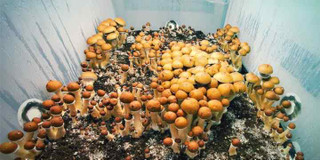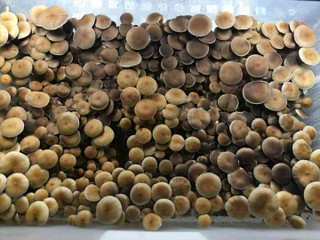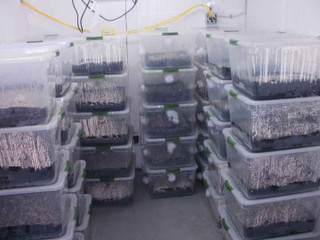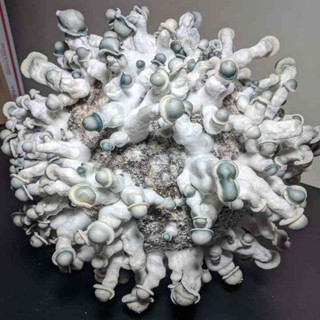Psilocybe cubensis: Distribution, Morphology, and Strains
Posted by Troy Cosky, Founder FunGuy Grow Supply on 9th May 2023

Welcome to the captivating world of psilocybin mushrooms, where ancient traditions meet cutting-edge modern science. Perhaps no other fungus has captured the attention and imagination of researchers and enthusiasts alike quite like Psilocybe cubensis. This remarkable species has a rich historical background, dating back centuries to its use in healing rituals by various indigenous cultures around the globe.
Research evidence continues to build up, demonstrating psilocybin's potential therapeutic benefits of the psychoactive drug tryptamine present in magic mushrooms. Our comprehensive article on Psilocybin Mushrooms and the Psychedelic Renaissance in America delves into the transformative power and potential therapeutic applications of psilocybin mushrooms, exploring their rich history, myriad benefits, and current legal status, providing an exclusive insight into unique forms of psychedelic therapy. As such, it's more important than ever to study the distribution, morphology, and common strains of Psilocybe cubensis.
In this article, we'll explore everything you need to know about unlocking the secrets of this extraordinary fungus. From its natural habitat and geographic range to its distinctive physical characteristics and identifying markers, we'll capture your imagination and leave you spellbound.
Join us on a mesmerizing journey into the fascinating world of Psilocybe cubensis - prepare to be captivated! FunGuy Grow Supply provides high-quality mushroom cultivation products for ethical and organic mycology enthusiasts who seek to grow mushrooms legally and responsibly, and FunGuy Grow Supply does not condone the use or manufacture of any illicit substance including psilocybin and psilocin.
How to Find Magic Mushrooms? Distribution and Habitat

The distribution of Psilocybe cubensis is not constrained to any specific geographical location, and it is fascinating to find these mushrooms in diverse regions worldwide. This posits a puzzling question: what factors influence their cosmopolitan distribution? It could be environmental factors such as humidity, temperature variance, altitude, light exposure/tolerability, or availability of nutrients in the soil.
Psilocybe cubensis mushrooms have a natural habitat that ranges from grasslands, forests, woodlands, mosslands, and riparian zones to burned lands. They also exhibit a significant affinity with cow dung deposits, as evidenced by how they flourish after consuming organic substrates such as feces. They have a high saprotrophic capability, breaking down live/dead organisms, which is a feature common among fungi with versatile metabolism and nutrient utilization capacity.
Common Strains and Geographic Distribution

- Psilocybe cubensis strains are found frequently in subtropical regions that receive rainfall throughout the year or during monsoons. These mushrooms can be traced back to parts of South and Central America, including Mexico and Panama.
- Observations by mycologists over time have revealed common regions where these fungi are prevalent, such as Australia, Southeast Asia (Thailand), West Africa (Ghana), Hawaii (Molokai), Indonesia, and Papua New Guinea.
What is particularly remarkable about the Psilocybe genus of mushrooms is its ability to thrive in human-dominated landscapes, such as parks or manure rich farming environments, including chicken coups or cow pastures.
Determining how Psilocybe cubensis adapts readily to several habitats allows scientists and enthusiasts to develop innovative cultivation techniques. This also provides an opportunity to learn more about its ecological impact when growing in the wild, with a focus on safe mushroom cultivation techniques that serve both medicinal and recreational purposes. These efforts aim to eliminate destructive practices in harvesting this vital resource, thus minimizing its impact on our environment. If you're keen on acquiring psilocybin spores specifically for microscopy purposes, reputable websites like SporeWorks present excellent avenues to explore, serving as valuable resources for your needs.
Morphology and Identification
The striking physical appearance of Psilocybe cubensis is a marvel that never ceases to amaze. Every feature and marking tells a unique story, begging exploration and admiration. The cap of the mushroom ranges from 1-8 cm in diameter, exhibiting a conical to convex shape with an irregular margin. As Psilocybe cubensis matures, it can become plane-shaped or funnel-like with a sharply defined umbilicate top.
One distinct aspect present is its hygrophanous nature, which changes color when touched by moisture or humidity. When dry, the surface of the cap appears to be reddish-cinnamon brown or golden-yellow depending on strain and climatic factors, but when wet, it fades into pale yellow tones. Some strains, such as "Albino Penis Envy," may feature an all-white cap throughout their whole life cycle.

Inspecting underneath, we find its gills clustered together beneath the mushroom cap with unequal length and various shades from light grey to dark brown colors. Additionally, they exhibit purple-brown spore prints developed after maturity, occurring five days after the veil has ruptured, exposing the mushroom gills.
A fascinating characteristic worth noting is this mushroom's blue staining reaction when damaged or bruised due to a group of mildew toxins known as psilocin oxidase. This reaction occurs gradually right after contact and intensifies over time.
Despite exhibiting unique and distinctive markers making identification easier for trained eyes, caution must always be observed when exploring in wild settings as similar-looking species pose potential harm like lethal poisonous Amanita & Galerina mushrooms, sometimes not distinguishable without careful attention.
Psilocybe Cubensis goes through various growth stages and life cycles:
- Spore Development: Spores develop into a compact network of white cobweb-like mycelium. They usually encircle plant remains or substrates and feed on dung deposits, which are common habitats for Cubensis.
- Sclerotia Formation: The mycelium develops into egg-shaped structures called sclerotia, which sprout stems when optimal environmental conditions, such as temperature, humidity, and light, are met.
- Fruiting Body Maturation: The maturation of fruiting bodies takes about 3-4 weeks. A cluster of mushroom pins will emerge, and their caps undergo a notable color change, indicating full maturity.
Observing this cultivation process provides a chance to witness Mother Nature's magical transformational journey in creating these fascinating fungi.
Intriguingly, recent studies suggest that the distinctive morphology of Psilocybe cubensis might play a role in their psychoactive effects on humans. This morphology provides specific compounds and nutrients that aid mushroom metabolization within our digestive system. As a result, there are absorption differences compared to other mushrooms. This discovery opens new doors for further exploration and studies on how our bodies process these marvelous mushroom elements, leading to potent psychedelic effects.
Cultivation Methods
Recreational growers overwhelmingly embrace monotubs as their go-to method for cultivating mesmerizing psilocybin mushrooms. Monotubs may be the way to go. These simple yet effective containers have become increasingly popular among growers due to their ease of use and high yield potential.

To start, you'll need a few key materials like a clear plastic tote, perlite, and vermiculite. Sterilization or pasteurization is critical for killing off any contamination, which can be achieved through pressure cooking or boiling techniques.
Once you've prepared your monotub, it's time to add your substrate - a mixture of grain spawn and coir or manure. The grain provides nutrients for the fungi, while the coir creates a moist environment that encourages growth.
One of the benefits of using monotubs is that they require little maintenance and allow for substantial yields. Plus, their small size makes them perfect for novice growers who are just starting on their cultivation journey.
To determine the appropriate amount of substrate needed for your specific growing container or monotub, you can make use of FunGuy's handy Substrate Calculator. This tool allows you to input the dimensions of your container and the desired ratios of spawn and bulk ingredients. It will automatically calculate the volume of each substrate component, the total substrate volume, and even the percentage of spawn and bulk ingredients in the final mix. Additionally, the calculator provides the volume of spawn required for your chosen substrate mix, making it a valuable resource for precision in your cultivation process.
Growing in Indoor Greenhouses or Grow Chambers
While monotubs work exceptionally well in restricted spaces, indoor greenhouses and grow chambers offer greater flexibility in terms of environmental control. To create an ideal growing environment, these setups involve carefully managing variables such as light exposure, humidity levels, and temperature fluctuations inside the chamber.

Ultrasonic humidifiers are often used in conjunction with automated controllers that regulate humidity by triggering misting cycles regularly. Additionally, exhaust fans help maintain consistent air circulation while reducing airflow restrictions.
Growing indoors also has its advantages, including safety from outdoor contaminants and hands-on control over parameters such as light inputs, air quality, and growth mediums, ensuring optimal growth conditions.
Whether you choose to cultivate with monotubs or indoor setups optimized using cutting-edge equipment, successful psilocybin mushroom cultivation isn't complicated. With careful attention paid to sterilization methods and precise environmental controls, you can expect glowing results.
Step Up Your Indoor Cultivation with the Best Humidifiers!
Achieving the ideal conditions in your grow chamber or indoor greenhouse starts with the right humidifier. Whether you're using monotubs or advanced equipment, our guide reveals the top humidifier choices for optimal growth conditions. Click here to learn which humidifier complements your setup best!
Common Psilocybin Strains
If you're curious about exploring the world of magic mushrooms, you'll be delighted to learn about some common strains that promise an unforgettable experience. From beginners to experienced cultivators, there's a strain suited for everyone.

B+ Strain
Let's start with the B+ strain - a classic favorite among many enthusiasts. Its origins can be traced back to Florida in the 1990s and have since become one of the most popular sought-after strains worldwide. The B+ strain is adored not only for its pleasant appearance but also due to its resilience against contaminants and ease of cultivation. Growers can expect large flushes with minimal effort compared to other strains. Furthermore, it tends to produce a pleasant balance between visual effects and introspection - perfect for beginners who want a comfortable experience.
Penis Envy (PE) Strain
Moving on to the enigmatic Penis Envy (PE) strain – characterized by its unique appearance lending from a mutation during past cultivation attempts accidentally done by Terence McKenna himself - an enthusiastic mycologist credited with popularizing magic mushrooms in Western culture. Over time, vendors have given this strain alternative names like Melmac and Homestead PE, adding to its diverse appeal in the market. This potent strain has gained much esteem among seasoned cultivators due to its psychedelic effects being known as very intense, though not commonly used by casual users - mainly because it requires more time or expertise than other simpler strains like B+. Cultivating PE or any variation, including Albino Penis Envy and Penis Envy Uncut requires considerable patience as colonization rates tend to be slower and may present more challenges when growing.
Tidal Wave Strain
If you want something extraordinary resulting from crossing two psilocybin mushroom species together, then look no further; behold Tidal Wave: A hybrid between B+ and Penis Envy strains! When cultivated correctly under optimal conditions - with proper sterilization methods - this marvelous union promises mind-bending visuals that will undoubtedly leave an individual feeling revitalized. With its characteristic wavy gills and vibrant fruiting body, this unique strain stands out from the crowd. But beware, as it can also be more potent than the parent strains separately.
Golden Teacher Strain
Next in line is Golden Teacher, which has gained popularity for various reasons and is known for its ease of cultivation coupled with a high level of potency. Mycologists have been pioneering the creation of groundbreaking strains like True Albino Teacher (TAT), Ghost, MVP (TAT x PE), and Albino MVP (AMVP), expanding upon the renowned lineage of this beloved strain. It has a classic appearance - light to golden brown caps with whitish stems - therefore being known for its friendly nature to both seasoned cultivators and beginners alike. When consumed, this strain leaves an individual feeling content, euphoric, creative, and curious accompanied by visual hallucinations. Therefore commonly sought after exploring the mind's creative depths or self-awareness.
Treasure Coast Strain
Then, we have Treasure Coast - A relatively new addition to the psilocybin family whose specific growing area and discoverer remain unknown but were first described on Shroomery in 2006. This strain comes in two main forms - white or rusty orange-brown caps - with an albino (leucistic) version being available too occasionally - making this rarity a collectors' item among enthusiasts. Quantitatively tested specimens indicate that Treasure Coast's potency often reported as "super strong" is more likely comparable to other average strains like Koh Samui or Golden Teacher. Nonetheless provides a delightful experience resembling lucid dreamscapes leaving users feeling clear-headed and relaxed.
Psilocybe Natalensis
Psilocybe natalensis is a distinctive and potent species, exhibiting an unconventional growth pattern compared to traditional strains. Thriving in subtropical grasslands and nutrient-rich soils, it displays robust rhizomorphic growth, enhancing its natural resistance to bacteria and mold. This unique addition to the psilocybin mushroom family offers exceptional potency and an intriguing alternative for mushroom enthusiasts.
Jack Frost
Finally, meet Jack Frost - a relatively new strain with snowflake-like appearances that evoke feelings similar to wintertime magic during light doses while producing strong hallucinations at higher doses. These mushrooms earned recognition as recreational champions. Nonetheless, general care must be taken when cultivating even common Psilocybin strains like Jack Frost in regulated settings because improper use may lead to potentially dangerous results.
Conclusion
As we reflect on our exploration of Psilocybe cubensis, it becomes clear that these mushrooms have an undeniable impact on both history and modern society. With their roots in ancient healing practices, psilocybin mushrooms present a revolutionary remedy for depression, obsessive-compulsive disorders, and end-of-life anxiety, highlighting their astounding therapeutic capabilities.
While significant strides have been made in the cultivation methods and refinement of strains like B+, Penis Envy, Tidal Wave, Golden Teacher, Natal Super Strength (Psilocybe natalensis), Treasure Coast, and Jack Frost among others, it's important to approach them with responsibility. As FunGuyGrow Supply has emphasized throughout this article series, safe mushroom cultivation should be a priority for everyone seeking their benefits.
Nevertheless, there remains a vast realm of knowledge yet to be uncovered regarding these enigmatic fungi. Further research can provide insight into their health benefits while helping dispel misconceptions surrounding psychoactive substances and improving public dialogue around drug policy reform.
As we conclude this journey of discovery with Psilocybe Cubensis, let us remember to keep an open mind and continue advocating for responsible use and access to accurate information. The secrets of this fascinating species will undoubtedly continue to enrich our understanding of the natural world and our place within it as we peer into uncharted territories of knowledge and self-discovery.
References
- Stamets, P. (1996). Psilocybin Mushrooms of the World: An Identification Guide. Ten Speed Press.
- Lowe, H., Toyang, N., Steele, B., Valentine, H., Grant, J., Ali, A., Ngwa, W., Gordon, L. (2021). The Therapeutic Potential of Psilocybin. Molecules, 26(10), 2948. doi: 10.3390/molecules26102948.

